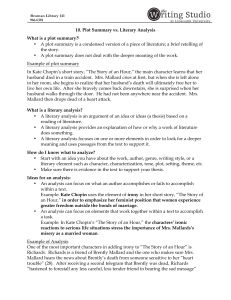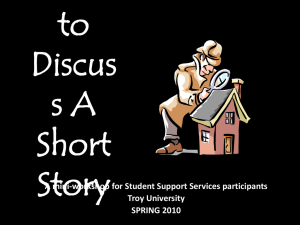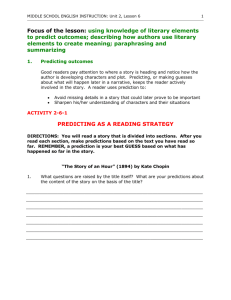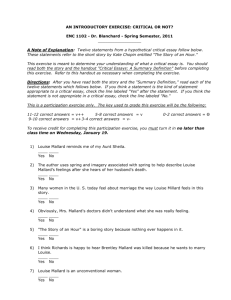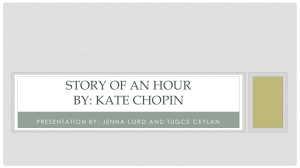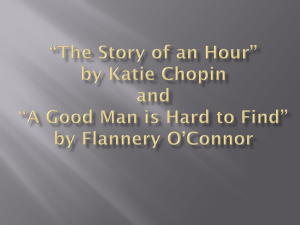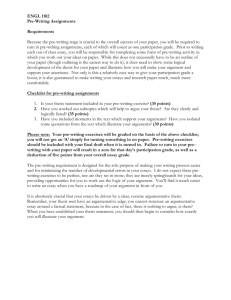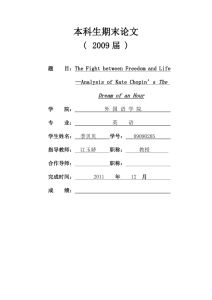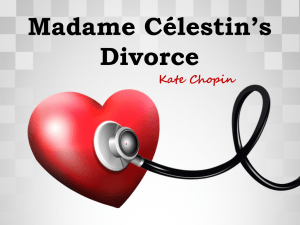Literary Analysis 101 PPT
advertisement
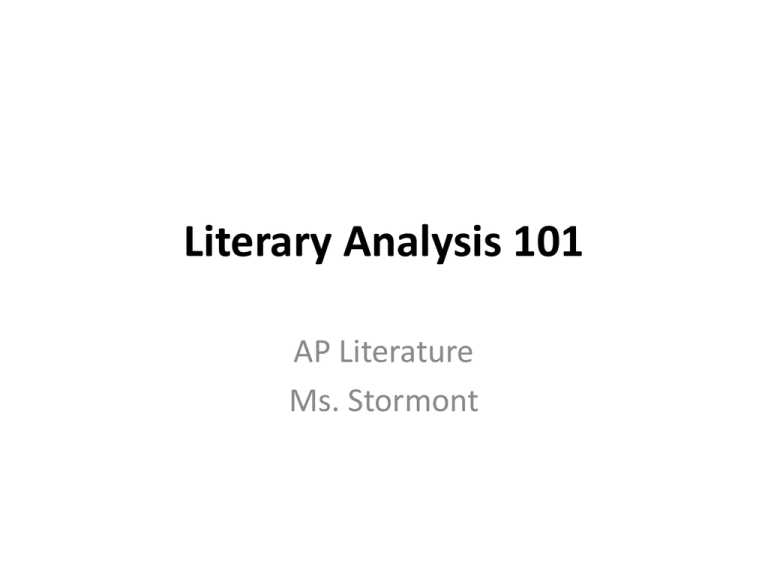
Literary Analysis 101 AP Literature Ms. Stormont Summary vs. Literary Analysis • Summary: A condensed version of a piece of literature; a brief retelling of the story. – Example: In Kate Chopin’s short story, “The Story of an Hour,” the main character learns that her husband died in a train accident. Mrs. Mallard cries at first, but when she is left alone in her room, she begins to realize that her husband’s death will ultimately free her to live her own life. After she bravely comes back downstairs, she is surprised when her husband walks through the door. He had not been anywhere near the accident. Mrs. Mallard then drops dead of a heart attack. Summary vs. Literary Analysis • Literary Analysis: An argument based on a text. – Provides an explanation of how or why a work of literature does something. – Focuses on one or more elements/techniques in order to look for a deeper meaning and uses passages from the text to support it. • EXAMPLE: Literary technique – Kate Chopin uses the element of irony in her short story, “The Story of an Hour,” in order to emphasize her feminist position that women experience greater freedom outside the bonds of marriage. Meaning (i.e. theme) Literary Analysis: Example • Perhaps the most important characters in adding irony to “The Story of an Hour” is Richards. Richards is a friend of Brently Mallard and the one who makes sure Mrs. Mallard hears the news about Brently’s death from someone sensitive to her “heart trouble” (28). After receiving a second telegram that Brently was dead, Richards “hastened to forestall any less careful, less tender friend in bearing the sad message” (28). Richards is also the one who attempts to shield Mrs. Mallard from seeing her husband when he arrives home quite alive, but this time he is too late. Ultimately, Richards’ sense of timing is at the core of Mrs. Mallard’s heart failure. If he had waited to bring the news of her husband’s supposed death, she would not have realized that without him she would be free, and she would not have “died of heart disease – of a joy that kills” (29). Debatable claim Gives examples (i.e. text evidence) of how Richards adds irony Commentary tying the examples (text evidence) back to the claim So… How do I come up with an analytical claim? • You can do this inductively or deductively. Inductive What it means: You gather lots of text evidence and literary techniques and come to a conclusion about what the author is trying to say. For example: I noticed that Chopin uses lots of diction and imagery related to imprisonment. This leads me to believe that Louise feels trapped – like many women at the time – in an unfulfilling marriage. Thus, I think that through her diction and imagery of imprisonment, Chopin comments that marriage – though joyful for some – can hinder an individual’s sense of personal agency in the world. What a beautiful claim! Notice how the writer ties literary technique to meaning (theme). So… How do I come up with an analytical claim? • You can do this inductively or deductively. Deductive What it means: You come to a conclusion or general idea, and then search for text evidence to support your conclusion. For example: I think Chopin is saying that internal transformations – no matter how extreme – can happen quicker than one might expect. The title suggests the story unfolds within the span of an hour, yet Louise goes from being shocked and weeping “with sudden, wild abandonment” about her husband’s death to finding a certain “joy” and “possession of self-assertion” that she had not previously had. Nice theme statement How do I write this thing? • The three basic parts: claim, evidence, warrant. (AKA claim, support, explanation.) – Start with your claim: what is the major point you are trying to prove? • If you’re writing an essay, your main claim will be your thesis; subclaims will be topic sentences. • If you’re writing a paragraph or an explication, your main claim will probably be your first sentence. – Introduce pieces of evidence/support. • In the form of: summary, paraphrase, quotation. • Skilled writers will use all three. – Explain how the evidence proves your claim. • This is, perhaps, the most forgotten or misunderstood part. You cannot let evidence “speak for itself.” You must show your thinking on the page of how the evidence ties back to your claim. Without this, your “analysis” becomes just a laundry list of pieces of evidence. Integrating evidence into your analysis • Summary – retelling the events of a story • Paraphrase – putting the author’s words into your own (rephrasing) • Quotation – using the author’s exact words in your own text Example In “The Story of an Hour,” Kate Chopin uses funereal diction to suggest that, for 19th century women trapped in unfulfilling marriages, death was a form of freedom. Richards, Brently Mallard’s friend, comes to Louise “bearing the sad message” of her husband’s death. This weighty word – “bearing” – connotes a sense of burden, almost as if Richards is the metaphorical pallbearer for his friend. Then, as Louise reflects on the shocking news in her room, she imagines the “long procession” of years ahead of her. “Procession” heightens the emotional and psychological load of her husband’s death, implying the slow, dirge-like passing of future time. Ultimately, though, it is Louise’s death (not her husband’s, ironically) that grants her the freedom that she hungers for. Debatable claim Evidence integrated in the form of a summary with a quotation Explanation connecting the evidence to the claim Another Example Kate Chopin uses the element of irony in her short story, “The Story of an Hour,” in order to emphasize her feminist position that women experience greater freedom outside the bonds of marriage. In a short sixty minutes, Louise Mallard goes from weeping with “sudden, wild abandonment” to self-realization: that she, now that her husband is dead, has “possession of selfassertion.” This profound yet startlingly swift internal transformation remains unknown to the other characters in the story, including her sister and her husband’s friend, Richards. As Louise walks downstairs with this newfound sense of personal agency, she sees that, in fact, her husband has not died, and falls over dead. To her husband, sister, and Richards, Louise apparently died from “the joy that kills” – the overwhelming happiness of having her husband return home alive and well. The reader, instead, finds this line remarkably ironic; Louise has not died from joy, but rather from grief. By carefully building tension and unfolding the personal transformation of Louise, the last line of the story provides a biting commentary on the constricting, burdensome nature of patriarchal societies – that even the thought of continuing on in a tepid marriage can be cause for death. Debatable claim Integrating evidence through quotations and analytical summary to build the argument Explanation of how the irony contributes to the claim
